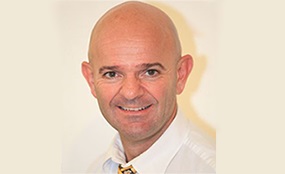
Besides repelling water, superhydrophobic materials can be useful in a myriad of applications. Anti-ice, anti-corrosion and anti-bacterial systems, oil/water separation, water purification and desalination, and drug delivery are just a few examples. At the XVI B-MRS Meeting, this wide range of possibilities will be presented in a plenary lecture by Professor Frédéric Guittard.
Together with his research group at the University of Nice Sophia Antipolis (France), Guittard gets inspiration from nature to create hydrophobic and oleophobic surfaces based on conductive polymers and other materials. In these topics, the group has dozens of patents and articles (seven of them, highlighted in the covers of journals of Chemistry, Polymers and Materials since 2014), and is among the few most cited groups in the world.
Frédéric Guittard obtained his doctoral degree in Organic Chemistry in 1994 from the University of Nice Sophia Antipolis, and remained in the institution as a postdoc for about a year. Between 1995 and 1996, he carried out postdoctoral internships at institutions in the cities of Padua (Italy), Preston (United Kingdom) and Prague (Czech Republic). From 1996 to 1997, he worked in the pharmaceutical industry in the Principality of Monaco.
In 1997, he returned to his alma mater, the University of Nice Sophia Antipolis, as an associate professor, becoming a full professor in 2002. From 2004 to 2010, he was the director of the university’s Chemistry Department. Concerning laboratory leadership, Guittard coordinated the Laboratory of Chemistry of Organic and Metallic Materials and, since 2017, leads a new laboratory, the N.I.C.E. ®, whose name refers not only to its location in the city of Nice, but also to the acronym of “Nature Inspires Creativity Engineers”. In addition, Guittard created, and already directs, a professional master’s degree program in Materials and Management at the University of Nice.
In 2012, 2014 and 2016, Guittard was the chairman of the first editions of the international conference on materials inspired by nature, also identified with the trademark N.I.C.E.
Currently, Guittard is a visiting professor at University of California, Riverside (USA).
His scientific production, which has more than 5,200 citations, includes books, more than 230 articles and 35 patents.
Here follows an interview with the scientist
B-MRS Newsletter: – Your research has a biomimetic approach. In what elements of Nature do you take inspiration to develop your hydro and oleophobic materials?
Frédéric Guittard: – From an artichoke. My kids wanted me to grow an artichoke: when I watered it, surprisingly I rediscovered the Lotus effect. The next steps were to adapt, to adopt, to integrate this secret from Nature into technologies or biotechnologies.
B-MRS Newsletter: – In your opinion, what are your main scientific or technological contributions in the field of hydrophobic and oleophobic materials? Please describe them briefly, and share the paper reference, if possible.
Frédéric Guittard: – There are some interesting applications for superhydrophobic or superoleophobic materials. The main applications concern the anti-adhesion (like anti-graffiti, anti-icing, anti-fingerprints …) or anti-bioadhesion (like anti-fouling or for example to remove bacteria from surfaces in hospitals). The following publications will give more details:
– Bioinspired Superhydrophobic Surfaces: Advances and Applications with Metallic and Inorganic Materials, CRC Press, Francis & Taylor Group, 300 pages, 2017 (F. Guittard, T. Darmanin)
– Superhydrophobic and Superoleophobic Properties in Nature, Materials Today, 2015, 18, 273-285 (T. Darmanin, F. Guittard)
– Recent advances in the potential applications of bioinspired superhydrophobic materials, Journal of Materials Chemistry A, 2014, 2, 16319-16359 (T. Darmanin, F. Guittard)
B-MRS Newsletter: – Your laboratory has an extensive list of industrial partners. Is university-to-industry knowledge transfer common in your laboratory? If so, in what way does it happen? Via patent licensing, spin-offs, joint projects?
Frédéric Guittard: – The first point is to understand that Industries and Universities are not competitors but can form a chain of value. In this way, the industries have to innovate in order to improve or to create the service. The Universities can help the industries to show amazing solutions with a proof of concept. Even if the cost is important to take into account, the key point at 80% for success is the good human relationship. More often, the solution is near us and the effort is weak! We have to see and to observe in order to find the key parameter and to ask the question where is the best in class from all the phenomena in the world (not only in the same field). It is like the benchmarking approaches.
Patent, licensing, spin-offs or joint projects can be used according to the origin of the idea and its realization.
More information
On XVI B-MRS Meeting website, click on the photo of Frédéric Guittard and see his mini CV and the abstract of his plenary lecture: http://sbpmat.org.br/16controter/home/
